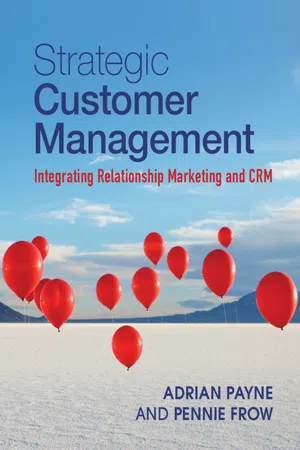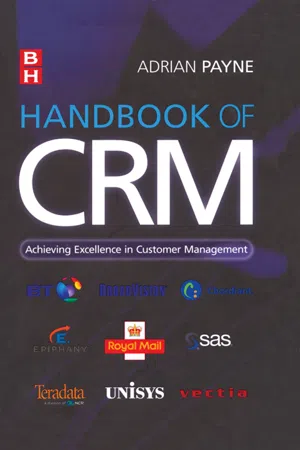Marketing
Marketing Information Management
Marketing Information Management involves the collection, analysis, and utilization of data to make informed marketing decisions. It encompasses processes for gathering market research, customer feedback, and competitive intelligence to understand consumer behavior and market trends. By effectively managing marketing information, organizations can tailor their strategies and campaigns to meet the needs and preferences of their target audience.
Written by Perlego with AI-assistance
Related key terms
1 of 5
12 Key excerpts on "Marketing Information Management"
- eBook - PDF
- David C. Bojanic, Robert D. Reid(Authors)
- 2016(Publication Date)
- Wiley(Publisher)
6.1.1 Marketing Information Systems A marketing information system (MIS) is the structure of people, equipment, and procedures used to gather, analyze, and distribute information needed by an organization. These are the data to be used as a basis for marketing decisions. Marketing information system is a broader and more encompassing term than marketing research, which is just one component of a management infor- mation system. Market research is focused on acquiring information for a specific research objec- tive or project, representing a one‐time use. For example, a potential restaurant owner may undertake a feasibility study and use market research to determine whether to build a new restau- rant in a certain location based on the demographics of the area. Such an information‐gathering study is designed to answer a very specific question: “Should we open this type of restaurant in this area?” A marketing information system, by contrast, is part of an ongoing data‐gathering process involving initial data collection as well as routine and systematic data collection procedures. For example, a hotel manager may choose to collect data by means of a zip code analysis of guest registration information to determine the geographic profile of the guests of a hotel. This system- atic and routine information gathering is not intended to address one specific question but is instead part of an overall system designed to monitor the degree of marketing success that the operation is able to achieve. A well‐designed marketing information system satisfies four basic criteria: • It must include a structured organization or established system of people and information‐ gathering procedures. • The system should be designed to generate a continuous flow of information to provide accurate and current marketing information for management. • Information should be gathered from inside and outside the organization. - eBook - ePub
- Paul Reynolds, Geoff Lancaster(Authors)
- 2005(Publication Date)
- Routledge(Publisher)
Marketing Information and Research
DOI: 10.4324/9780080455020-1414.1 Introduction
The American Marketing Association (AMA, 1961 , p. 1) defines marketing research as: ‘the systematic gathering, recording and analysing of data relating to the marketing of goods and services’. Kotler (1994 , p. 257) defined it as: ‘systematic problem analysis, model building and fact finding for the purpose of improved decision-making and control in the marketing of goods and services’. Doyle (1994 , pp. 39, 124) stated that marketing management consists of five tasks, one of which is marketing research and explains: ‘Management has to collect information on the current and potential needs of customers in the markets chosen, how they buy and what competitors are offering’.Research attempts to find reliable and unbiased answers to questions. Marketing research provides information in a systematic way about the markets for goods and services and probes people’s ideas and intentions on many issues. As explained in Chapter 2 , in a complex consumer society, there is little direct contact between producers and consumers. Marketing research can, by the collection, analysis and interpretation of facts, find out what it is that people want and ascertain why they want it. The application of techniques and methodology of marketing research are as applicable in the not-for-profit sector as in profit-making organisations.14.2 Marketing Information Systems
Effective marketing decisions are as good as the information on which they are based. Decision-making underlies the management process at every level and the terms ‘managing’ and ‘decision-making’ are synonymous. Marketing management is the process of making decisions in relation to marketing problems. Marketing research is utilised by marketing management when planning the marketing strategy of an enterprise. A disciplined and systematic approach to research methodology to the area of investigation is needed and a series of steps should be taken in developing, planning and executing research with a view to solving specific problems (Demirdjian, 2003 - eBook - ePub
- Alison Scammell(Author)
- 2003(Publication Date)
- Routledge(Publisher)
I begin with a definition of marketing and its relevance to the information sector. I then move on to look at the environment within which the Information Centre operates; the process of carrying out market research; the pros and cons of various methods of data collection and what to do with the information when you have collected it. I then briefly look at the importance of marketing in the context of the long-term future of the information profession.What is marketing?
What is marketing and what relevance does it have for the Information Manager? You may be surprised to read that marketing is not about persuading people to buy or use something which they do not really want or need. Marketing does not begin with a product or service and the marketer cannot create demand that does not exist. Marketing is not a magic formula for instantly increasing use of a service or product. The Chartered Institute of Marketing defines marketing as: ‘…the management process responsible for identifying, anticipating and satisfying customer needs profitably’.Michael J Baker (1987) suggests that real marketing has four essential features. It:- starts with the customer
- [takes] a long run perspective
- [makes] full use of all the company’s resources
- is innovative.
Note that both descriptions have the customer at the heart of the statements. Marketing however is not just a management process, it requires a shift in priorities—it becomes a way of working. We might be surprised by the logic and simplicity of the four points listed in Baker’s definition. Is there anything in these four points that an Information Manager in the context of the information service cannot do? I would suggest not.Is information inherently difficult to market? The customer does not see what he or she will get prior to being presented with the information. On taking the enquiry, the information provider may not know for a fact that the information being requested is available. The information provider may not know whether he or she will incur any charges in getting the information for the customer or that he or she can get the information in the time required by the customer. In short there are many uncertainties involved here but it is not just information a customer gets when using the information department, it is a service. An information provider is unlikely to be able to answer every - eBook - PDF
- James Burrow(Author)
- 2020(Publication Date)
- Cengage Learning EMEA(Publisher)
Editorial review has deemed that any suppressed content does not materially affect the overall learning experience. Cengage Learning reserves the right to remove additional content at any time if subsequent rights restrictions require it. 6.2 | Find and Manage Marketing Information 157 Businesses need a great deal of informa- tion to operate successfully. With all of the information needed, businesspeople could spend most of their time gathering and studying information. A marketing information system (MkIS, pronounced M-K-I-S) is an organized method of collecting, storing, analyzing, and retrieving information to improve the effectiveness and efficiency of marketing decisions. Manage Information Each business develops its own marketing information system. In a very small new business, an MkIS may be as simple as a filing cabinet in which the owner collects, organizes, and stores customer information, business records, and other information important to the business. Today, however, even small businesses maintain computer- ized records. Large businesses may have an information management unit with a dedicated computer system and a staff of people who collect and analyze information and prepare reports. The information man- agement staff is charged with collecting information in a cost-effective manner that is complete, accurate, easy to use, timely, and affordable. Design a Marketing Information System All effective marketing information systems contain five elements. Those elements are input, storage, analysis, output, and deci- sion making. In planning an MkIS, ques- tions relating to each system element need to be answered. The questions and related elements are shown in Figure 6-2. INPUT How do you make decisions? If you want to be as objective as possible and make good decisions, you must gather information. Input is the information needed for decision making that goes into the system. - eBook - ePub
- Geoffrey Lancaster, Lester Massingham(Authors)
- 2017(Publication Date)
- Routledge(Publisher)
Subsystems 1, 2 and 3 are data collection methods, whereas subsystem 4 is an analytical method. Together they provide a framework for marketing managers to marshal their thoughts into tactics and to assist management in seeing the important elements of a particular situation and examining the relationships between these elements. A successful MkIS provides a structure for the analysis, planning and control of a given set of activities. Creating an MIS and MkIS for any business is a complex, individualized process.Marketing research is concerned with the task of generating information, whereas the MkIS is focused on managing the flow of information to marketing decision-makers. This distinction is important because information is worthless unless it is relevant and effectively communicated.Inputs to the MkIS
The three inputs to the MkIS shown in Figure 13.1 are now examined individually.Marketing information systemFigure 13.1The internal accounting system
Internal company data can be a fruitful source of information, but it is often not fully utilized. Administrative and documentary procedures vary between companies, but most start with the customer’s enquiry and end with the customer’s invoice. In B2B environments it is possible to build a picture of the overall system from individual employees to the total departmental system and ultimately to the firm as a whole.Data from marketing/sales departments
These are the main points of commercial interaction between an organization and its customers. Consequently, a great deal of information should be available, including: - eBook - PDF
- Isaack Onyango Okwaro(Author)
- 2019(Publication Date)
- Society Publishing(Publisher)
The American Marketing Association officially explained MR to be a tool that relates the customer, consumer, and general public to the marketer over info. The word info is used to define and identify marketing problems and opportunities; refine, generate, and assess marketing movements; improve understanding of marketing as a process; and monitor marketing performance. It gathers facts on the challenge. The gathered information is tabularized, analyzed, and inferences are made. Then the references are specified for resolving the challenge. MR too delivers info to the marketing managers. Though, such info is info. It can only be employed for a specific objective. MKIS and MR are not replacements to one another. The range of MKIS is extremely broad. It comprises Market segmenta-tion is the process of dividing a mar-ket of potential customers into groups, or segments, based on different characteristics. Marketing Information System 157 of MR. On the other hand, the range of MR is very thin. 7.3. ADVANTAGES AND SIGNIFI-CANCE OF MARKETING INFOR-MATION SYSTEMS (MKIS) To start with, the first and foremost advantages which a business develops by the usage of IT-based MIS is developments in the reporting system. Van Bruggen et al., (2001), insisted that processing of information gets quicker and the management of the company becomes capable to link relevant info from various sources in the organization. Without the necessary IT infrastructure, it would be almost impossible to bring together such info in an expressively and unified manner. The objective of MIS applications is to join in inputs from several organizational roles into a meaningful and holistic map of firm’s doings, portraying its relations with customers, suppliers, and so on. Van Bruggen et al., (1998), Talvinen and Saarinen, (1995), concluded that as an outcome of performing this in an appropriate time, decision making is improved through depending more on evidences rather than intuition and gut-feeling. - eBook - PDF
- Carl McDaniel, Jr., Roger Gates(Authors)
- 2016(Publication Date)
- Wiley(Publisher)
Marketing Research and Decision Making Marketing research plays two key roles in the marketing system. First, as part of the marketing intelligence feedback process, marketing research provides decision makers with data on the effec- tiveness of the current marketing mix and offers insights into necessary changes. Second, market- ing research is the primary tool for exploring new opportunities in the marketplace. Segmentation research and new product research help identify the most lucrative opportunities for a firm. Marketing Research Defined Now that you have an understanding of how marketing research fits into the overall marketing system, we can proceed with a formal definition of the term, as stated by the American Marketing Association: Marketing research is the function that links the consumer, customer, and public to the marketer through information—information used to identify and define marketing opportunities and problems; generate, refine, and evaluate marketing actions; monitor marketing performance; and improve understanding marketing mix The unique blend of product/service, pricing, promotion, and distribution strategies designed to meet the needs of a specific target market. 4 CHAPTER 1 The Role of Marketing Research in Management Decision Making of marketing as a process. Marketing research specifies the information required to address these issues, designs the method for collecting information, manages and implements the data collection process, analyzes the results, and communicates the findings and their implications. 4 We prefer another definition: Marketing research is the planning, collection, and analysis of data relevant to marketing decision making and the communication of the results of this analysis to management. Importance of Marketing Research to Management Marketing research can be viewed as playing three functional roles: descriptive, diagnostic, and predictive. - eBook - PDF
Strategic Customer Management
Integrating Relationship Marketing and CRM
- Adrian Payne, Pennie Frow(Authors)
- 2013(Publication Date)
- Cambridge University Press(Publisher)
Thus it is important to keep the technological aspect of CRM in the correct perspective: as the means to an end and not the end itself. Information management Information management is about achieving an acceptable balance between operating intelligently and operating idealistically. Consider the following scenario. The heart surgeon may have all the latest equipment, superlative training and a genuine commit-ment to saving the life of his patient, but if he operates on the basis that he is replacing a valve in a serious but routine procedure, rather than working to rectify the multiple complications he fi nds once the patient ’ s chest is opened, he will probably fail in his efforts to help and possibly with fatal consequences. So who will be to blame? The surgeon 352 CUSTOMER RELATIONSHIP MANAGEMENT: KEY PROCESSES for not knowing enough about his patient ’ s unique needs and condition and not being prepared for the unexpected, or the patient for not forwarding more information about the patterns or progression of her illness? Often we do not know what it is we need to know to address a problem, or by the same token, what we really do not need to know. Clearly, neither the undersupply nor oversupply of information is satisfactory. The quest is therefore to fi nd the right information and at the right time. Learning that the patient has a family history of a rare coronary disease after she has fallen into a coma on the operating table is of little comfort or bene fi t. This analogy serves to emphasise the constituent dimensions of information: quality, quantity, relevance, timing, ownership and application. The function of information management in the CRM context is to transform information into usable knowledge and to apply this knowledge effectively and ethically in the creation of customer value. The acronym ‘ DIKW ’ – data , information , knowledge and wisdom – is used fairly extensively within the information technology industry to describe this process. - eBook - PDF
- Carl McDaniel, Jr., Roger Gates(Authors)
- 2020(Publication Date)
- Wiley(Publisher)
Marketing Research and Decision Making 3 Marketing Research and Decision Making Marketing research plays two key roles in the marketing system. First, as part of the market- ing intelligence feedback process, marketing research provides decision makers with data on the effectiveness of the current marketing mix and offers insights into necessary changes. Second, marketing research is the primary tool for exploring new opportunities in the mar- ketplace. Segmentation research and new product research help identify the most lucrative opportunities for a firm. Marketing Research Defined Now that you have an understanding of how marketing research fits into the overall market- ing system, we can proceed with a formal definition of the term, as stated by the American Marketing Association: Marketing research is the function that links the consumer, customer, and public to the marketer through information—information used to identify and define marketing opportunities and problems; generate, refine, and evaluate marketing actions; mon- itor marketing performance; and improve understanding of marketing as a process. Marketing research specifies the information required to address these issues, designs the method for collecting information, manages and implements the data collection process, analyzes the results, and communicates the findings and their implications. We prefer another definition: Marketing research is the planning, collection, and anal- ysis of data relevant to marketing decision making and the communication of the results of this analysis to management. Importance of Marketing Research to Management Marketing research can be viewed as playing three functional roles: descriptive, diagnostic, and predictive. Its descriptive function includes gathering and presenting statements of fact. What is the historic sales trend in the industry? What are consumers’ attitudes and be- liefs toward a product? Opening a pack of bacon is a messy job. - eBook - ePub
- Adrian Payne(Author)
- 2012(Publication Date)
- Routledge(Publisher)
Chapter 5
The information management process
The strategy framework for CRMThe information management process is concerned with two key activities: the collection and collation of customer information from all customer contact points and the utilization of this information to construct complete and current customer profiles which can be used to enhance the quality of the customer experience, thus contributing to the value creation process. As companies grow and interact with an increasing number of customers through an increasing diversity of channels, the need for a systematic approach to organizing and employing information becomes ever greater. Two questions are of special importance in the information management process:1. How should we organize information on customers? 2. How can we ‘replicate’ the mind of customers and use this information to improve our CRM activities?Where customer information is spread across disparate functions and departments, interactions with the customer are based on partial or no knowledge of the customer, even though the customer may have been with the organization for years. This fragmentation of customer knowledge creates two major problems for the company. First, the customer is treated in an impersonal way, which may lead to dissatisfaction and defection. Second, there is no single unified view of the customer upon which to act and to plan.In an effort to keep pace with escalating volumes of data, the tendency has been for organizations to create more or bigger databases within functions or departments, leading to a wealth of disparate silos of customer information. Companies are thus left with a fragmented and often unwieldy body of information upon which to make crucial management decisions. The elevation of CRM from the level of a specific application such as a call centre, to the level of a pan-company strategy requires the integration of customer interactions across all communication channels, front-office and back-office applications and business functions. What is required to manage this integration on an ongoing basis is a purposefully designed system that brings together data, computers, procedure and people – or what is termed an integrated CRM solution. This is the output of the information management process. - Ken Kaser, Dotty Oelkers(Authors)
- 2018(Publication Date)
- Cengage Learning EMEA(Publisher)
Nielsen is quick to point out that word-of-mouth recommendations from friends and family are still the most trusted sources of information about products and services. Think Critically 1. Visit the Nielsen website and look at examples of data collected about entertainment. Name two kinds of data that are collected. How does Nielsen collect this data? 2. How can data collected about the viewership of a TV show be used by a potential advertiser? 125 © Jason Stitt/Shutterstock.com 126 Chapter 5 MARKETING-INFORMATION MANAGEMENT LO 5.1-1 FINDING MARKETING SOLUTIONS When a theater sells out every performance of a play, the pro-ducers consider this a form of positive feedback from customers. If customers keep buying, that means they are happy. Successful businesses continuously consider how to keep current customers and find new customers. Businesses need to know what is and what is not working. Marketing information collected from customers can be used by businesses to help make needed improvements. A marketing-information system (MIS) is a set of procedures and methods used to systematically collect, analyze, distribute, and store information needed by business managers to make deci-sions, including decisions about how to please customers. Learning Objectives Key Terms LO 5.1-1 Explain the characteristics and purposes of marketing- information systems. LO 5.1-2 Describe the role of ethics in marketing-information management. • marketing-information system • syndicated research • soft data • marketing research • client-side researchers • hard data The Essential Question What are the characteristics and purposes of marketing-information systems, and what role do ethics play? 5.1 Marketing-Information Systems Most theater productions on Broadway in New York City begin with several weeks of preview performances in theaters outside of New York.- eBook - ePub
- Nigel Piercy, Martin Evans(Authors)
- 2014(Publication Date)
- Routledge(Publisher)
PART IIIMANAGING MARKETING INFORMATION
7DEVELOPING MARKETING INFORMATION SYSTEMS Introduction
Reviewing the progress of the discussion to this present point high-lights the rather different role for Part III of the book, and for this chapter in particular. While Part I sought to establish the legitimacy of the MkIS concept — in the company but also in the channel and the product-market — and, indeed, that of marketing information itself, Part II was concerned with the role and use of each of the major types of marketing information source, varying from environmental scanning to complex model-building.The goal now, in Part III , is to examine the development and design of the MkIS in a company. The central focus is marketing managers’ information needs, not the technology of computing and communication. The thesis advanced is that there are a number of powerful attractions in approaching the MkIS from the users’ point of view, rather than that of the systems specialist, and, indeed, for arguing that this may be a distinguishing factor between success and failure in MkIS design. In its crudest terms, the hypothesis is that understanding the needs for information and the way it is used by marketing managers is more fundamental than any particular piece of equipment or technological capability.The procedure here is to examine in some detail the problems in measuring marketing information needs and to establish an operational approach to this task, and then to examine what is involved in matching informational resources and capacities to those information needs.A further implication of emphasising marketing information user needs, as the central focus for analysis, is that information should be seen in its organisational and behavioural context. As suggested at the outset (Chapter 1
Index pages curate the most relevant extracts from our library of academic textbooks. They’ve been created using an in-house natural language model (NLM), each adding context and meaning to key research topics.











